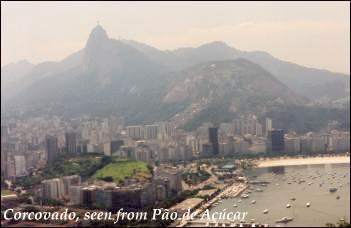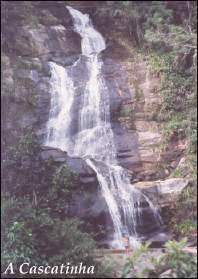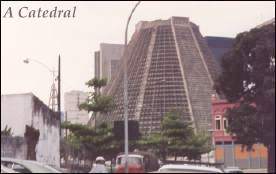



| | 
|
 The Pão de Açúcar, by cable-car. A formidable view. Plenty of tourists and cameras, plenty of tacky souvenirs, but really the atrações at the top are nicely done-- café, restaurant, tropical birds, gardens, even a little amphitheatre. Nothing playing today. Took a taxi there and a bus back, which was 10 times cheaper.
The Pão de Açúcar, by cable-car. A formidable view. Plenty of tourists and cameras, plenty of tacky souvenirs, but really the atrações at the top are nicely done-- café, restaurant, tropical birds, gardens, even a little amphitheatre. Nothing playing today. Took a taxi there and a bus back, which was 10 times cheaper.
When I got back, Roberto was just arriving, with a squishy package the size of a bag of rice, which turned out to be milk. We took a taxi over to Adriana's, and borrowed her car, so he could show me the sights. (Adriana wasn't feeling well, and stayed home.)
 We went through the Parque Nacional da Tijuca, a long ride up, up to the top of the mountains scattered around town, through forested roads carved from the rock, past grand vistas of mountain and city. It is these mountains that make Rio such a beautiful city. The architecture is only slightly better than São Paulo; but there is the beautiful backdrop of the sea and the mountains-- deep green trees, grey rock-- and, from the mountain, spectacular views of the city.
We went through the Parque Nacional da Tijuca, a long ride up, up to the top of the mountains scattered around town, through forested roads carved from the rock, past grand vistas of mountain and city. It is these mountains that make Rio such a beautiful city. The architecture is only slightly better than São Paulo; but there is the beautiful backdrop of the sea and the mountains-- deep green trees, grey rock-- and, from the mountain, spectacular views of the city.
On the way back we passed through Barra da Tijuca, a pleasant little suburb whose beach, Roberto says, is now or soon will be the nicest, hippest beach in Rio, in the precession that has moved from Botafogo/Flamengo ('30s) to Copacabana ('50s) to Ipanema ('70s, '80s). Barra is much less crowded, more open, than Ipanema. We also passed São Conrado, plus a few beachside favelas in between São Conrado and Leblón.
Afterward we had dinner at the Churrascaria Copacabana, where we each had huge steaks (mine was a very peppery steack ao poivre), which we couldn't finish-- a circumstance aided by the restaurant's huge couvert, or appetizer.
We talked more about the favelas. Roberto thinks they shouldn't be allowed-- they're nasty and unsafe-- but says there's no easy solution. The favelados don't want to move: the favelas are close to work, close to the beach, and it costs nothing to live there-- water and electricity are filched from the city. But they cannot become permanent communities-- they're perched on 70o inclines, and can't be improved without destroying them. Things might be better if Rio finishes its subway, which now doesn't even go to Copacabana, much less Barra.
Roberto agrees that Brazil could one day be a great power. He thinks the major problems facing Brazil are 1) the debt, 2) American protectionism, 3) corruption, 4) a weak and leaderless government, and 5) poverty. Like others I've met, he deplores the current leaders and politicos. He says Brasília is a nice place, despite the bad people who live there (the politicians).

| | 
|
First thing, did some errands: bought stamps, changed money, confirmed my flight home. Changing travelers' cheques is a real drag here-- I've been changing my few dollars instead. This gives me the full parallel rate-- today, Cz$ 1,080.
Back at Roberto's, picked up camera, and headed out to Corcovado. I took a taxi to the little train, and the driver attempted to sell me a trip up the mountain for Cz$ 20,000. He said it was cheaper-- than what, I can't say, because my Portuguese gave out-- than hiring a motorcade, I suppose. Other folks outside the train station wanted to sell me jewelry, bus rides, taxi rides. A soccer star apparently said in a commercial once that O importante é levar vantagem-- the important thing is to press your advantage. These guys have it down to a science. But a few quick judo moves and I was free.
The train up to Corcovado (Cz$ 2,000, ida e volta) makes a few stops, mainly for the benefit of the favelados who inhabit the lower stretches of the mountain. The upper part is all tropical forest, a part of the same one Roberto took me through, the Parque Nacional da Tijuca.

Corcovado, by the way, like all the mountains here, is amazingly steep, but in addition it has a little projection at the top, as if it urgently wanted to be 200 feet higher; this little spur is where the statue of Christ is. At the top you come to a mess of souvenir stands, the parking lot where you'd come if you drove, and a staircase up to the statue of Cristo Redentor, whose back is to you. You go up the monumental staircase and reach the statue itself, 130 feet high, and gaze out over the city. The view is truly amazing, tho' dimmed by haze today. I got a nice picture of Christ with the sun just behind his head-- the only way to deal with the sun, which otherwise would spoil the picture, tho' this didn't stop everyone else.
There's a sign on most taxis-- Respeite o Turista-- Respect the Tourist. In case you don't know what one is, one is helpfully pictured: a man with outrageous shirt, Bermudas, and camera. The Innocent Abroad. Really, it's not hard to see why tourists get a bad name-- I was listening to some know-it-all Americans on the ride up explaining things to a German tourist-- "Yes, we say Chilly, but they call it Cheelay." (At least she pronounced Buenos Aires as Bweh-nos Ay-res-- not as Maggie Thatcher calls it, Bew-ness Airs.)
I had a fruit juice and popsicle at the café halfway up the stairs, and took the train back. An American couple sitting next to me were perturbed when the train started heading downhill-- they expected it to go up. Where they got this idea I can't say, as we started at the top of the railway, and it just don't go any highter; but there they were. They got off at one of the intermediate stops, and were presumably rescued by the next train up.
 Back in Cosme Velho, the neighborhood at the foot of the mountain, I let a disreputable character persuade me to take his taxi to the Cathedral in center city, for Cz$ 4000. When we got there I refused his offers of tours of Rio or Brasília or Amazônia by means of the simple strategem of grinning and leaving. He warned me that it was a dangerous neighborhood, and I swallowed the comment that it would be less so once he'd left it.
Back in Cosme Velho, the neighborhood at the foot of the mountain, I let a disreputable character persuade me to take his taxi to the Cathedral in center city, for Cz$ 4000. When we got there I refused his offers of tours of Rio or Brasília or Amazônia by means of the simple strategem of grinning and leaving. He warned me that it was a dangerous neighborhood, and I swallowed the comment that it would be less so once he'd left it.
The Cathedral is a modern concrete structure, the shape of an anthill, but uglier. It has to be considered one of the great failures of modernism-- dingy concrete, windowless, graffiti-ridden, set in a vast parking lot, and soon eclipsed in memory by the tineset colonial-style chapel. There was no way to get inside; God's church wasn't letting anyone but him in, perhaps for fear that people would mistake it for a bus terminal, or a bank-- probably the IMF.
 From here it was a short but tiring walk to the Praça Mahatma Gandhi, the heart of downtown Rio. I walked up Avenida Rio Branco and then Avenida Presidente Vargas. Downtown Rio feels much different from Ipanema. No beachware, for one thing. It's more crowded, more businesslike, even more high-rise. There's shopping streets where everything not available in the stores is being sold on the sidewalks. The newstands-- bancas, I think-- stock more dirty magazines-- things with titles like Teen Sex and Inches. There are also street vendors with pictures of Jesus, Charlie Chaplin, and Ché Guevara-- not in a group portrait, I mean, but pretty close.
From here it was a short but tiring walk to the Praça Mahatma Gandhi, the heart of downtown Rio. I walked up Avenida Rio Branco and then Avenida Presidente Vargas. Downtown Rio feels much different from Ipanema. No beachware, for one thing. It's more crowded, more businesslike, even more high-rise. There's shopping streets where everything not available in the stores is being sold on the sidewalks. The newstands-- bancas, I think-- stock more dirty magazines-- things with titles like Teen Sex and Inches. There are also street vendors with pictures of Jesus, Charlie Chaplin, and Ché Guevara-- not in a group portrait, I mean, but pretty close.
I took a bus back-- Cz$ 112. Why the buses have fares like this I don't know; it netted me some one-cruzado coins in change. Lica says that if you drop these, no one will pick them up.
The bus trip was long, but it did give me a glimpse of Flamengo and Botafogo, including the museums, a Charles Addams structure called something like the Castelinho de Flamengo, and the white-walled Hotel Gloria.
I crashed once I got back to Roberto', and barely had the strength to go out again, at about 9.30, to eat. I ended up at Alberigo's, and had the vatapá, a Bahian dish-- a sort of chunky, coconutty seafood stew.
I'm distressed to report that I haven't seen much of the Southern stars. It's the fault of this city living. I looked tonight, but it was cloudy.
An expression of the difference between São Paulo and Rio is the signs on the taxis. São Paulo's say, solemnly, QUE DEUS NOS PROTEJA SEMPRE (May God protect us always). Rio's say RIO, EU GOSTO DE VOCÊ (I like you, Rio), with the O in RIO a woman's lips.
A TV commercial for a liquor called Sampedrense offers a series of idyllic coisas do Interior, presumably including Sampedrense itself. But the list is interesting as a catalogue of the urban Brazilian's picture of life in a small town: working in the fields-- a ltitle feijãozinho-- a lute serenade-- a small-town band-- a nap in a hammock-- all in warm, rich colors. If Walt Disney were Brazilian, this would be his matrix.
Another TV show has an opening sequence worthy of Python: a gang of pirates, cutlasses and all, invade a TV studio, fight their way to the control booth, and insert their own tape, which purports to be the program shown-- TV PIRATA.
Oranges aren't orange here-- they're orange and green. They're not treated with day-glo dyes. Ah, primitive innocence.
Had a little diarrhea about an hour ago. Think I'm going to have some more. Not enough bran in the diet. [ 2002 note: Actually this happens every time I visit Latin America-- the only difference between places is in how long it takes to strike. My stomach is resolutely First World. ]

| | 
|
